Law Review Crouch a Trademark Justification for Design Patent Rights
 In TrafFix Devices v. Mktg. Displays, the Supreme Court held that the existence of an expired utility patent covering a item product design provides strong evidence that the design is "functional."* Consequently, a party would be had-pressed to claim not-functional trade clothes protection for the previously patented design. In Keystone Mfg. v. Jaccard Corp., the Westward.D.Northward.Y. federal court explored how trade dress protection is impacted by an expired design patent.
In TrafFix Devices v. Mktg. Displays, the Supreme Court held that the existence of an expired utility patent covering a item product design provides strong evidence that the design is "functional."* Consequently, a party would be had-pressed to claim not-functional trade clothes protection for the previously patented design. In Keystone Mfg. v. Jaccard Corp., the Westward.D.Northward.Y. federal court explored how trade dress protection is impacted by an expired design patent.
Expired Blueprint Patent: Jaccard'south hand held meat tenderizer is covered by its U.S. Pattern Patent No. D 276,685. The blueprint patent expired in 1998 – seemingly leaving an open up avenue for direct copycat competition. Every bit part of a larger lawsuit, however, Jaccard asserted trade dress rights over its product.
Functionality: Jaccard argues that blueprint patents should be treated equally the mirror image of utility patents in a functionality assay: If a utility patent creates strong proof of functionality, a pattern patent should provide presumptive evidence of non-functionality.
The district court rejected the suggestion that the design patent creates a presumption of not-functionality. Instead, the court held that the design patent simply serves equally another piece of bear witness to be used by the jury in determining non-functionality. This conclusion comports with McCarthy on Trademarks:
"A blueprint patent, rather than detracting from a claim of non-functional trade dress or trademark, may support such a merits . . . [West]hile a design patent is some evidence of not-functionality, alone it is not sufficient without other prove."
Curiously absent from this conclusion is any assay of the populist notion that expiration of a patent transfers to the public a right to copy and use the patented elements.
- * Although there are various definitions of functionality, in merchandise dress police force the term by and large refers to whether the element is essential for the product'due south use or affects the price/quality of the production. But non-functional designs are protectable as trade dress.
- Keystone Mfg. five. Jaccard Corp., 2007 U.Due south. Dist. LEXIS 13094 (Westward.D.N.Y. February 26, 2007).
- There are several cases in conflict with Keystone Mfg on this signal. Fuji Kogyo Co., Ltd. five. Pac. Bay Int'50, Inc., 461 F.3d 675 (6th Cir. 2006) (noting that a blueprint patent serves every bit presumptive testify of non-functionality).
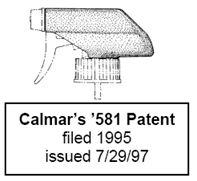 Saint-Gobain Calmer, Inc. (at present MeadWestvaco Calmer) five. Arminak & Associates, Inc. (on petition for certiorari 2008)
Saint-Gobain Calmer, Inc. (at present MeadWestvaco Calmer) five. Arminak & Associates, Inc. (on petition for certiorari 2008)
In 2007, the Federal Excursion dealt a serious blow to pattern patent protection by determining that an intermediate corporate purchaser is the "ordinary observer" for infringement analysis. A professional person corporate purchaser is presumably more than likely to run into differences between the patented blueprint and an accused infringing device — thus making infringement more hard to prove.
Calmer's design patent, for case, covers a sprayer shroud that is so combined with the trigger mechanism, bottle, etc.; filled with some liquid; and shipped to Wal-Mart for retail sale. The Federal Excursion's property looks to the typical heir-apparent at the signal where the allegedly infringing shroud is outset sold to determine whether that private would believe that "the patented pattern every bit a whole is substantially the same as the accused design."
Calmer has at present petitioned the Supreme Courtroom request two questions:
- Whether the [Federal Excursion'southward] use of good viewpoints to determine blueprint patent infringement is in direct disharmonize with this Court'south decision in Gorham Co. v. White, 81 U.Southward. 511, 529 (1871)?
- Whether the [Federal Circuit'southward] test for design patent infringement of a component product, which considers deceptive similarities merely as to the beginning purchaser of any product including the patented design, directly conflicts with its own precedent and with this Court'southward "ordinary observer" test mandated by Gorham Co. v. White, 81 U.S. 511, 529 (1871), by excluding not merely unsophisticated purchasers but too later purchasers of products including the patented blueprint every bit a component?
As I write in an upcoming newspaper, the justification for design patent protections is more akin to traditional trademark policy than utility patent policy. With that in mind, it makes some sense allow design patents to operate at the retail level.
Notes:
- Dennis Hunker,Corporate Parts Buyer as Ordinary Observer, Patently-O (Sept fourteen, 2007).
- See too, Egyptian Goddess v. Swisa (en banc 2008)
- File Attachment: Calmer Petition (503 KB)
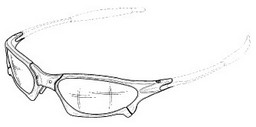 Oakley recently sued Fox, Curiosity, and others for infringement of its design sunglasses design patent No. D470,166. Co-ordinate to the complaint, the movie industry has knocked-off Oakley'south design to promote Silver Surfer DVDs.
Oakley recently sued Fox, Curiosity, and others for infringement of its design sunglasses design patent No. D470,166. Co-ordinate to the complaint, the movie industry has knocked-off Oakley'south design to promote Silver Surfer DVDs.
Oakley owns over 100 blueprint patents on its various sunglass designs. Since 2004, the style trend-setter has filed over 30 complaints against defendant infringers.
 Apparently, Mardsen wore 18-carat Oakley in his role as Cyclops. What damages if they had been fakes?
Apparently, Mardsen wore 18-carat Oakley in his role as Cyclops. What damages if they had been fakes?
- Design Patent Law: The Business firm Subcommittee on IP held hearings on amendments to the design patent laws. The two primary specific issues on the table are (1) whether to eliminate blueprint patents covering replacement car parts and (2) whether to extend IP protection to style designs. [LINK]. The IP group volition hold PTO oversight hearings again next week.
- Replacement Parts: IPO recently voted to oppose whatever legislative exemption for item products or technologies from the IP laws: "In particular, IPO opposes legislation that would exempt replacement automobile parts from infringing U.South. design patents."
- LexisNexis Patent Center: lexisnexis is at present in the blog world with their "Patent Center."
-
 Missing Dates: The PTO revived Aristocrat'southward national stage application even though filed a day late. During litigation, even so, the district court found the revival an improper extension of the law. [Link] The patentee appealed to the CAFC with the question of "Whether a patent application abased for failure to comply with deadlines set forth in 35 UsC. §§ 371(d) and 133 may exist revived based on mere 'unintentional' delay where those provisions provide for revival only for "unavoidable" delay." Now, IGT responds.
Missing Dates: The PTO revived Aristocrat'southward national stage application even though filed a day late. During litigation, even so, the district court found the revival an improper extension of the law. [Link] The patentee appealed to the CAFC with the question of "Whether a patent application abased for failure to comply with deadlines set forth in 35 UsC. §§ 371(d) and 133 may exist revived based on mere 'unintentional' delay where those provisions provide for revival only for "unavoidable" delay." Now, IGT responds. - New Authoritative Guess: According to Hal Wegner, the PTO has appointed Professor Lorelei Ritchie de Larena to the position of authoritative approximate on the TTAB BPAI. Judge Ritchie has been working in tech-transfer for several years while educational activity at the same time. As the rate of appeals continues to rise, the PTO will need to continue to rent loftier quality judges. At the same time, these judges volition brainstorm to experience an even stronger pull to bound send to police force firms looking for inside feel and connections. [Related note: can someone send me a listing of BPAI Judges? dcrouch@patentlyo.com]
Over the past decade, the PTO has taken control of pendency problems in the pattern patent expanse. In the early 1990'due south design patents averaged over 30 months in prosecution. By 2001, that boilerplate pendency had fallen to less than 15 months.
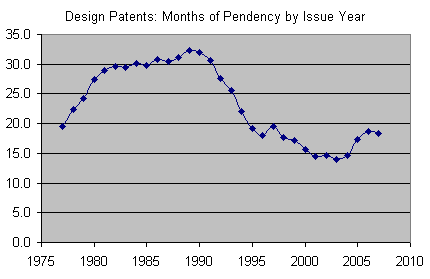
The depression pendency tin let blueprint patents to serve equally a preliminary substitute for future trade dress protection. A design patent application offers firsthand 'patent pending' condition and would, in all likelihood, issue earlier the product would garner the secondary meaning sufficient for trade wearing apparel protection. This is the approach taken by Apple with its iPod design patent applications. One of its issued iPod blueprint patents (US D549,237 filed Aug 24 2005) appears identical to the company's trademark design application (Serial No. 78925932 filed July 2006). The trademark case is all the same pending because Apple must make the required showing of secondary meaning.
The major problem with this 'patent then trademark' approach is the narrow scope generally offered by blueprint patents during litigation. This may change as the Federal Circuit is set to reconsider its design patent infringement jurisprudence in the upcoming Egyptian Goddess en banc case.
There are major differences between the design patent examining corps and the utility patent examining corps — most notably, pattern patent examiners appear to stay-put. The 49 primary examiners associated with patents issued on December 4, 2007, take, on average, examined 3200+ design patents as primary examiners over an average of 12.5 years. (Medians of 3047 and 11.v years respectively). Approximately 2/3 of design patents are prosecuted by one of the chief examiners without whatever assistance from an assistant examiner. For the aforementioned patents, assistant examiners have an boilerplate history of 400 examined design patents over a period of 2 years. (Median of 200 and 18 months respectively).
* The graph above is based on a recently compiled dataset of the entire set of 300,000+ design patents issued between December, 1976 and Dec, 2007.
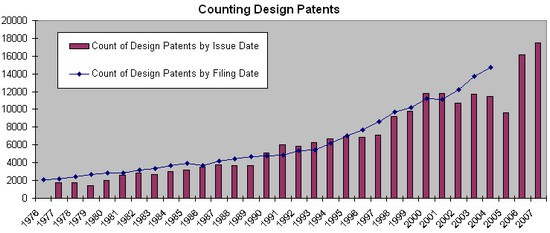
In 2007, Samsung Electronics received over 550 pattern patents — the near e'er issued to a single company in one year. Sony holds the most design patents, and is followed closely by Nike. The following table shows the visitor awarded the near design patents each yr:
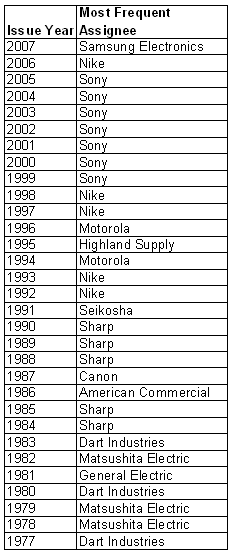 Louis Zarfas is the primary examiner associated with the most issued design patents. Mr. Zarfas has allowed over 16,000 design patents since his offset (as a primary) in 1978. Over 1,000 of those design patents relate to shoe designs claimed by companies such equally Nike, Reebok, AVIA, Asics, LA Gear, Rockport, Sketchers, Wolverine, Keds, Louis Vuitton, Timberland, Berluti, and Kangaroos.
Louis Zarfas is the primary examiner associated with the most issued design patents. Mr. Zarfas has allowed over 16,000 design patents since his offset (as a primary) in 1978. Over 1,000 of those design patents relate to shoe designs claimed by companies such equally Nike, Reebok, AVIA, Asics, LA Gear, Rockport, Sketchers, Wolverine, Keds, Louis Vuitton, Timberland, Berluti, and Kangaroos.
Recently issued design patents (issued 2000–2007) were, on average, awaiting for 16.ii months. Companies with at least 100 design patents during that period had about 1 month less pendency than those with fewer patents. Nike has prosecution downwardly to a science — and averages less than 9 months pendency (filing to issuance). Toward the other stop of the pendency chart, Apple averages over 21 months.
During the 2000–2007 menstruum, approximately 75% of examinations were handled past primary examiners without any assistance from an assistant examiner. As with utility patents, the pendency for cases without an banana is significantly less than for those with an assistant. Here, the difference is about two months.
* These numbers are based on a recently compiled dataset of 300,000+ design patents issued since 1976 on file with DDC.
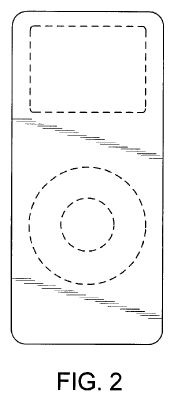 35 U.s.C. § 171 is a unifying provision – briefly stating that "except as otherwise provided," the unabridged Patent Deed applies every bit to both utility patents and design patents. Thus, blueprint patents must fit within the requirements of §§120 and 112. [ane] On the other hand, § 122 expressly exempts design patents from the publication requirements.
35 U.s.C. § 171 is a unifying provision – briefly stating that "except as otherwise provided," the unabridged Patent Deed applies every bit to both utility patents and design patents. Thus, blueprint patents must fit within the requirements of §§120 and 112. [ane] On the other hand, § 122 expressly exempts design patents from the publication requirements.
The enigma is § 101 and its definition of utility. Department 101 includes no explicit exception for designs. But, even a novice observer would question how a non-functional ornamental design tin at the same time be "useful?"
The Supreme Courtroom appears to accept answered this query in Footnote five of its 2001 opinion in J.E.Chiliad. Ag Supply 5. Pioneer Hi-Bred. [two] In that case, the Court held one time again that the patentable discipline matters scope of 35 U.Due south.C. § 101 is "extremely broad" and that the scope for utility patents certainly includes plants despite the existence of § 161 "establish patents."
In Footnote v, the Court briefly compares § 101 utility patents with § 161 institute patents and § 171 blueprint patents. "Patents issued under § 161 are referred to as 'plant patents,' which are distinguished from § 101 utility patents and § 171 blueprint patents." [iii]
The implication from the Court's comparison is that design patents are not subject area to the requirements of § 101 (despite the lack of whatsoever statutory exceptions). Thus, a patented design must exist "new, original[, ] ornamental [and] an article of industry." Notwithstanding, the design need not be useful.
[one] In re Daniels, 144 F.3d 1452 (Fed. Cir. 1998).
[2] J.E.M. Ag Supply 5. Pioneer Hi-Bred Int'l., 534
[3] Id. at fn. v.
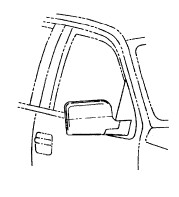 In re Certain Automotive Parts, 2007 WL 2021234 (ITC 2007)
In re Certain Automotive Parts, 2007 WL 2021234 (ITC 2007)
Ford Motor Company owns dozens of design patents covering various aspects of its vehicle designs. D496,890, for case, covers a vehicle grille; D493,552 covers a vehicle head lamp; D503,135 covers a bumper lower valance; and D496,615 covers a side view mirror. In 2005, Ford initiated a Section 337 activeness before the International Merchandise Committee (ITC) asking for an exclusion order against various auto parts importers whose imports violated the Ford design patents. For the near function, the accused parts are used to repair post-crash vehicles.
An administrative constabulary judge (ALJ) constitute that the majority of the asserted patents were valid and infringed, although some patents were invalid. The ITC then issued an order to exclude importation of the unlicensed repair parts.
Repair doctrine: Over the years, courts take created a non-statutory doctrine of permissible repair. Nether the doctrine, mail-sale repairs made to a patented object are not considered actionable. On the other hand, reconstruction of the patented object will exist actionable as an unlicensed "making" of the invention.
Although interesting, the repair doctrine does non apply here. The accused infringers are not repairing anything — rather, they are importing replacement parts that on their own are infringing.
Calls for Patent Reform: After losing on the merits, the would-be importers take jumped on the patent reform bandwagon asking for a "repair parts" exception to the blueprint patent laws. [Quality Parts Coalition]. Car manufacturers would like to go the other manner — adding vehicle hull design protection to the Copyright Act. [Come across Gunkhole Hull statute]
Appeal: The case, captioned as Ford v. ITC, 07–1357, is at present on appeal at the CAFC — A decision is expected summertime 2008. The critical question for Ford — will the patents pass the CAFC'southward dreaded points-of-novelty test?
- Lemley (Stanford) & Myhrvold (IntVen) have released a short article on "how to make a patent market." They suggest that an information gap is 1 problem creating friction in licensing negations. The solution — crave publication of patent assignments and license terms. [LINK]
- Over the past few weeks, we take directed some focus on the protection of industrial designs. Why? (1) the law surrounding protection of industrial designs is in disarray; (2) I expect that protection of industrial designs will become more important as utility patent protection becomes more difficult and more costly; and (3) if well protected, industrial designs & fashion rights may well exist worth more than the value of all not-pharmaceutical utility patents.
- New Patent Law Job Postings:
- Patent Engineer V – Novellus Systems – Silicon Valley
- Patent Engineer III – Novellus Systems – Silicon Valley
- Patent Prosecution – Schneck & Schneck – San Jose
- Electrical Applied science Patent Chaser – Washington DC
- Sr Mechanical Acquaintance – Litig and opinions – Washington DC
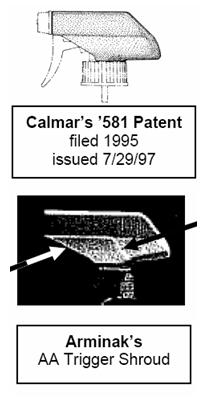 Arminak v. Saint-Gobain Calmer (Fed. Cir. 2007).
Arminak v. Saint-Gobain Calmer (Fed. Cir. 2007).
In withal some other serious blow to blueprint patent protection the Federal Circuit has affirmed a lower courtroom ruling that Arminak's spray nozzle design is not infringed by Calmer.
Design patent infringement is defined both in 35 UsaC. 271 and 289. According to Section 289, a pattern patent is infringed by unauthorized commercial manufacture, use, or sale of the design or a "colorable imitation."
Whoever during the term of a patent for a blueprint, without license of the owner, (ane) applies the patented design, or any colorable fake thereof, to any article of manufacture for the purpose of sale, or (ii) sells or exposes for sale any commodity of manufacture to which such design or colorable imitation has been practical shall be liable to the owner to the extent of his full profit, but not less than $250, recoverable in any United States district court having jurisdiction of the parties. 35 U.S.C. 289.
Infringement: Overshadowing the statutory guidelines is the CAFC's judicially created infringement jurisprudence. According to the CAFC, infringement requires satisfaction of two distinct tests: First, in the eyes of an "ordinary observer," the accused pattern as a whole must be deceivingly similar to the patented pattern. Second, the defendant blueprint must appropriate i or more than points-of-novelty that distinguish the design from the prior art.
Ordinary Observer: Like the PHOSITA in utility patent cases, the ordinary observer is a mythical being. However, instead of beingness 'skilled in the fine art,' the ordinary observer is aware of the patented design, but is non an expert in the art.
Arminak manufactures and sells spray nozzles. However, Arminak does not sell on a retail level. Rather, the nozzles are purchased by other manufacturers who join them with bottles total of product.
The corporate nozzle buyers can distinguish between Arminak & Calmer nozzles without much trouble. Once assembled, retail customers accept difficulty in distinguishing betwixt the nozzles one time assembled. The case then turns on whether the ordinary observer is defined equally the corporate buyer of the nozzle or a retail client of the fully assembled production.
Sitting by designation, Judge Holderman determined that the ordinary observer should be defined by the patentee's corporate structure. Because Arminak's products pass through a middle-human being for further processing, information technology cannot count the downstream retail purchasers as ordinary observers who "purchase and use" the sprayer. Rather, the ordinary observer is the corporate nozzle buyer. (Thus, eventual customer defoliation regarding the final product makes no difference).
It was undisputed that a corporate buyer would not be deceived by overall similarities betwixt the defendant and patented designs — thus no infringement.
Point of Novelty: The console also institute that the defendant blueprint did not appropriate whatever "points of novelty" of the patented invention. In doing and so, the court found that a side-past-side detailed comparison between the accused production and the patent design drawings was appropriate.
To establish infringement in a design patent case, the district court is required to compare the patented design with the defendant design. Without comparing the patented design with the accused design, there was no way for the district court to determine whether an ordinary observer would find the accused blueprint deceptively similar and whether the accused pattern appropriated points of novelty.
For utility patent experts, this type of analysis is 2nd nature. However, for over 100 years prior to founding the CAFC, the rule has been that design patent infringement jurisprudence does not let for such "side by side" examination. See Gorham Manufacturing Co. v. White, 81 U.S. 511 (1871) (rejecting a side-past-side comparison as leading to an 'expert' result rather than that of an 'ordinary observer').
 In the past twenty years, the Usa Patent & Trademark Office has issued simply over 268,000 design patents. During that time, almost exactly one percentage (i%) of those issued design patents have been litigated to some caste. (i.e., at to the lowest degree a complaint was filed asserting infringement of the patent). The virtually commonly litigated are design patents covering ornamental features of shoes (7% of litigated patents) and lamps (five% of litigated patents). Other commonly litigated products include piece of furniture (chairs & tables), eyeglasses, and golf equipment.
In the past twenty years, the Usa Patent & Trademark Office has issued simply over 268,000 design patents. During that time, almost exactly one percentage (i%) of those issued design patents have been litigated to some caste. (i.e., at to the lowest degree a complaint was filed asserting infringement of the patent). The virtually commonly litigated are design patents covering ornamental features of shoes (7% of litigated patents) and lamps (five% of litigated patents). Other commonly litigated products include piece of furniture (chairs & tables), eyeglasses, and golf equipment.
35 USC 171 outlines the telescopic of design patents equally "whatsoever new, original, and ornamental design for an article of industry." The MPEP narrows this definition to only include "visual characteristics" of a design – although a court could force the PTO to include other sensory characteristics. I doubtable a product with ornamental textures – even if not visually distinct — could exist protected (especially if the production was designed for bullheaded individuals). A farther (and improbable) stretch would exist to define blueprint to include associated music, scent, and sense of taste.
Source: https://patentlyo.com/patent/design-patent/page/2
0 Response to "Law Review Crouch a Trademark Justification for Design Patent Rights"
Post a Comment